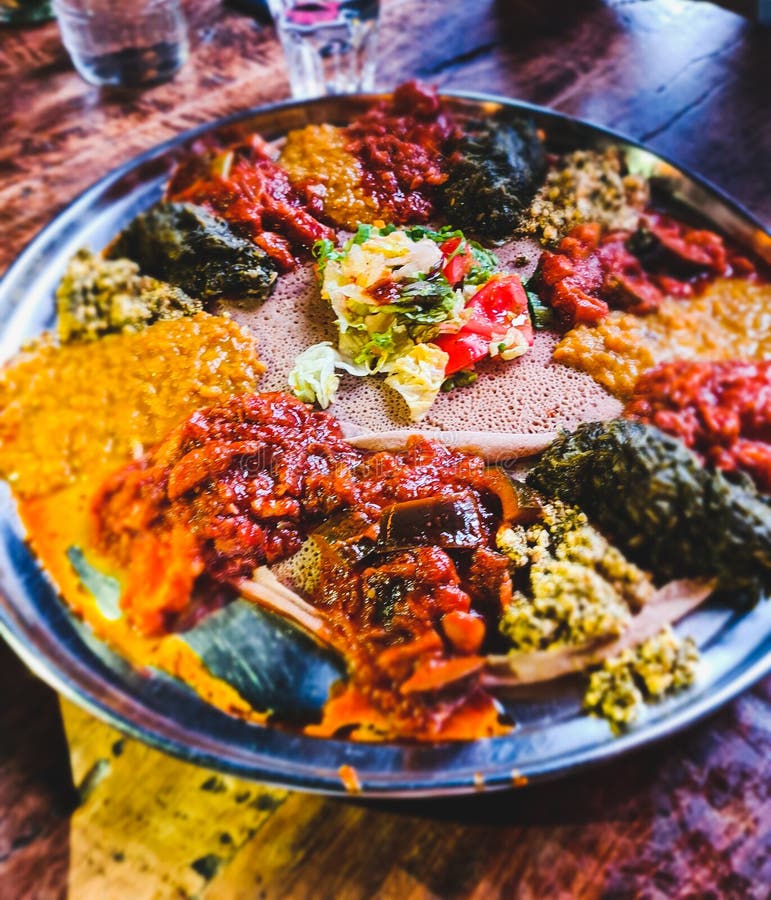Table Of Content

And because you'll probably get a taste of injera with every bite you take, its distinctive tang is one of the defining flavors of Ethiopian cuisine. Most people view it as a dish for special occasions, and it’s widely eaten on Orthodox Easter Sunday after 55 long days of fasting. In bigger cities, like Addis and Mekelle, it’s found year-round in special restaurants known as kitfo houses, where it’s the only thing on the menu. Wots, or stews, are a common Ethiopian dish, and one of the more common versions you'll see on restaurant menus is doro wot, or chicken stew. But put aside all thoughts of chicken pot pie filling or other familiar preparations –- doro wot is proof that ordering chicken doesn't mean settling for bland or familiar. And the good news is you won't have to – Ethiopian food is meant to be shared.
UNBELIEVABLY delicious

Translating literally as "a bit of every type," it's a colorful sampling of dishes that can include spiced lentils, potatoes, vegetable stews, and more. It's not only attractive to look at, but offers a variety of flavors and textures that can remind you how much flavor potential vegetables really have. Kitfo is traditionally esteemed for its high nutritional value and seen as a celebration food.
Queen Sheba Ethiopian Restaurant & Bar
Community rallies around family of beloved Charlotte restaurant owner killed in crash - WSOC Charlotte
Community rallies around family of beloved Charlotte restaurant owner killed in crash.
Posted: Tue, 24 Jan 2023 08:00:00 GMT [source]
Some versions get an extra flavor boost from spiced butter, an Ethiopian pantry staple consisting of clarified butter simmered with spices such as coriander, cinnamon, and cloves. Pieces of injera soaked in spiced berbere sauce, cooked with fresh diced tomatoes, onions, garlic, jalapeno peppers, and Enat’s special spices. While this hearty dish is popular on fast days, it's not seen as an abstemious dish by any means. Indeed, some variants –- such as tegabino shiro, which is thickened with flour and served still bubbling in a tiny clay pot –- are downright festive in their presentation. Shiro can also be served for breakfast, mixed with shredded injera (Ethiopian fermented flatbread) –- this makes the already hearty puree an even more fortifying way to start a busy day. For home cooks who want to try their hand at shiro, an easy shortcut to getting a super-smooth texture is to use chickpea flour instead of cooked, mashed chickpeas.
A Guide to Traditional Ethiopian Cuisine
Your 2024 ultimate guide to eating your way around Optimist Hall in Charlotte - Charlotte Observer
Your 2024 ultimate guide to eating your way around Optimist Hall in Charlotte.
Posted: Mon, 01 Apr 2024 07:00:00 GMT [source]
While tere siga, like most Ethiopian dishes, is served with injera, it also comes with a knife so diners can slice off bite-sized pieces at will. One legend states that it was first devised by military operatives in the 16th century as a way for soldiers to get their protein fix without lighting fires and being detected by enemy forces. The dish's popularity today makes an odd kind of sense in light on the heavily vegetarian diet kept by Ethiopia's majority Christian population. While observant Christians do forgo meat and dairy for nearly half the days of the year, most are not strict vegetarians. So on the days when their faith allows meat, they're happy to go all in. While Ethiopian cooking celebrates meat in all forms, it also has a long tradition of vegetarian cooking.

Our vegan platter with your choice of one tibs (lamb, beef, chicken or mushroom) with one extra side. Some of our dishes use traditional ingredients so we’ve included a small dictionary at the bottom. At Enat Ethiopian Restaurant, we are dedicated to elevating the status and awareness of Ethiopian cuisine by fusing modern creativity with authentic delicious taste. The only thing better than our food is our impeccable service, through which we demonstrate warmth, professionalism, and integrity. Served in equally distinctive bottles called bereles, these small glass beakers give off a hint of middle school biology nostalgia.
DORO WOTT
And while coffee has long been part of the Ethiopian landscape, it's never been taken for granted. The traditional Ethiopian coffee ceremony –- which you can experience yourself if you find the right restaurant, even in the U.S. –- shows the culture's reverence for coffee. First, the serving table is scattered with fresh grass to evoke the outdoors. Next, the hostess lights a stick of incense before showing the guests a pan of green coffee beans, which she roasts over an open flame before grinding.
DEREK TIBS
Yes, this means the meat is served virtually raw –- think of it as an Ethiopian analogue to steak tartare. But to play it safe, you can also order kitfo cooked, in which case the meat is heated more thoroughly with the spiced butter mixture). So it's not surprising that many popular Ethiopian dishes feature injera, the country's signature fermented flatbread, as their central ingredient. If you're a fan of fajitas, you'll want to try tibs, another classic of the Ethiopian kitchen. It's basically small slices or chunks of meat (either beef or lamb) quick-fried in butter with onions and garlic, but can take on a range of flavorings, from super-spicy to mild.
Whole brown lentils with onions and peppers, rolled with injera. Our Optimist Hall menu features classic dishes like the stuffed pastry Sambusa, the stir-fried meat and veggies Tibs, and the spongy bread Injera. Chunks of fish marinated in berbere spice and lime juice and then fried in sesame oil, olive oil and paprika, with grated garlic and ginger added. Mushroom sautéed with onion, garlic, tomato and red pepper and rosemary.
ENTHIOPIAN COFFEE
The ceremony coffee comes with a burning of Frankincense which was very calming and relaxing. The coffee is strong, hot and very good, very much in the traditional Ethiopian style... If you're a vegetarian -– or an omnivore who wants something lighter to balance out a rich meat dish -– beyainatu is exactly what you need.
But this concept is far from new, and Ethiopian cooks have been implicitly following the principles of nose-to-tail cooking all along. A case in point is dulet, a hearty dish of multiple cuts of meat – including tripe, liver, and lean meat – cut into small pieces and cooked together with a flavorful mixture of butter, chile, cardamon, onions, and pepper. The contrasting textures, from the chewy tripe and creamy liver, combine with the spices into a tantalizing whole. Even if you're not a huge fan of organ meat, this deeply flavored, protein-rich dish might change your mind. If you're a hard-core carnivore and resent the way vegetables and sauce get in the way of your meat in stews or other preparations, tere siga needs to be on your radar the next time you go out for Ethiopian food. One of Ethiopia's many meatless specialties is shiro, a highly seasoned puree of chickpeas or other legumes.
There’s a slight beery edge owing to a type of hop leaf used in the brewing. Be aware that with all uncooked meat, there’s an added risk of illness, most notably, tape worms and salmonella. Abugida Ethiopian Cafe & Restaurant based in Charlotte, NC specializes in delicious and reasonably priced Ethiopian cuisine, including our house specialties and other customer favorites.
It’s a simple classic, cooked with red onions stir-fry style, accompanied with fresh greens and ever-present injera. Depending on how it’s garnished, it can be a mild or spicy dish. Heat things up with sliced fresh green chilli and plenty of berbere sauce.

No comments:
Post a Comment